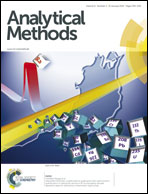Application of flower-like SnS2 nanoparticles for direct electrochemistry of hemoglobin and its electrocatalysis†
Abstract
Flower-like SnS2 nanoparticles were synthesized through a hydrothermal process . By combing with hemoglobin (Hb) and the ionic liquid (IL) 1-butyl-3-methyl-imidazolium tetrafluoroborate ([BMIM]BF4), a composite biomaterial was fabricated and further used to modify a carbon ionic liquid electrode (CILE) with Nafion as a film-forming material. FT-IR and UV-Vis spectroscopic results showed that Hb retained its native structure in the composite. With the synergistic effects of the SnS2 nanoflower and IL, a couple of well-defined redox peaks of Hb appeared in the cyclic voltammogram of Nafion/Hb–SnS2–IL/CILE, which indicated that direct electron transfer between Hb and the underlying electrode was realized. The electrochemical behavior of Hb on the modified electrode was investigated by cyclic voltammetry with the electrochemical parameters such as electron transfer coefficient (α), electron transfer number (n) and heterogeneous electron transfer rate constant (ks) calculated. The fabricated electrode showed good electrocatalytic ability for the reduction of trichloroacetic acid (TCA) with a wider linear range from 0.8 to 21.0 mM and a lower detection limit of 0.27 mM (S/N = 3), indicating its potential application for the construction of a novel third-generation electrochemical biosensor.


 Please wait while we load your content...
Please wait while we load your content...